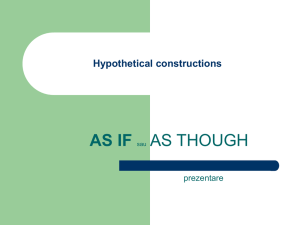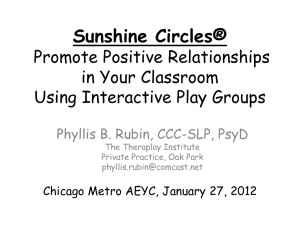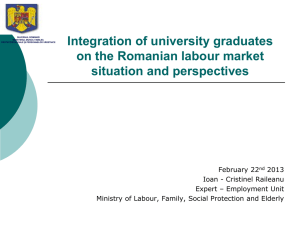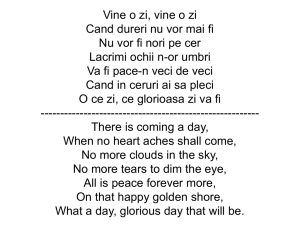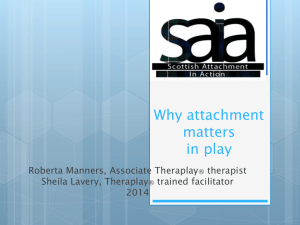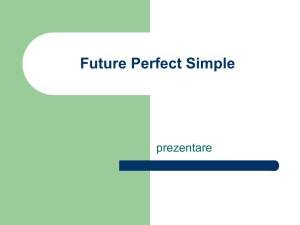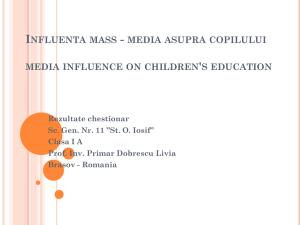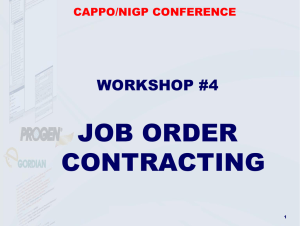Interventia parinte-copil - Mandel School of Applied Social Sciences
advertisement
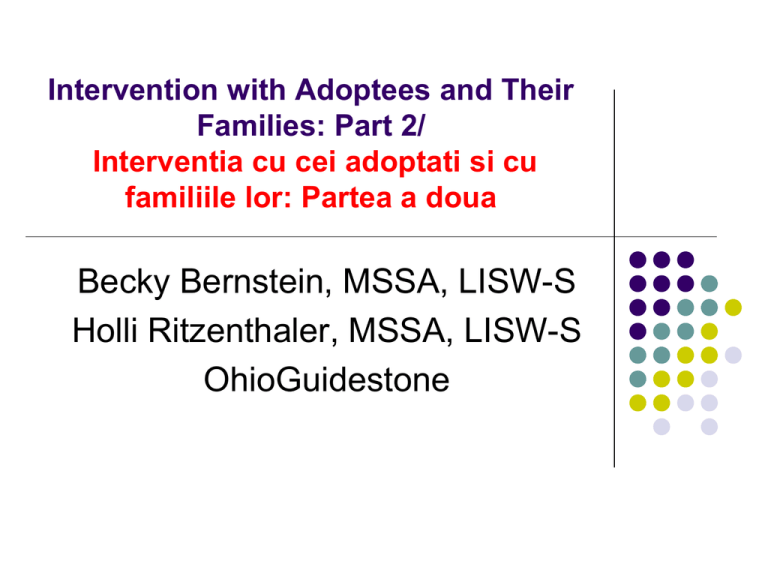
Intervention with Adoptees and Their Families: Part 2/ Interventia cu cei adoptati si cu familiile lor: Partea a doua Becky Bernstein, MSSA, LISW-S Holli Ritzenthaler, MSSA, LISW-S OhioGuidestone Agenda Review of the Intervention Goals/ Revederea obiectivelor interventiei Relational Paradigm of Intervention/ Paradigma relationala in interventie Intervention Techniques / Tehnici de interventie Main Goals of Intervention with Adoptive Families/ Scopurile principale ale interventiei cu familiile adoptive 1. 2. 3. 4. 5. Attachment/ Atasamentul Stabilize child in the family and build relationships/ Stabilizarea copilului in familie si construirea relatiilor Family Identity Development/ Dezvoltarea identitatii familiei Normalize/reframe feelings of ambivalence/ Normalizarea si redefinirea sentimentelor de ambivalenta Help family system re-stabilize & find new equilibrium/ Sprijinirea sistemului familiei sa se restabileasca si sa-si gaseasca un nou echilibru Validate parent’s decision to adopt/ Validarea deciziei parintelui de a adopta Grief & Loss/ Suferinta si pierdere Both child and family/ Atat copilul cat si familia Communication/ Comunicarea Open and honest about history, risks & strengths/ Deschisa si onesta cu privire la istoric, riscuri si aspecte pozitive Empathy & Understanding/ Empatie si intelegere Child’s emotional & behavioral challenges/ Provocari emotionale si comportamentale ale copilului Core Issues & all adoption constellation members/ Teme principale la toti membrii constelatiei adoptiei Foundational Principles of Intervention/ Principii fundamentale ale interventiei The parent is the primary agent of change/ Parintele este agentul primar al schimbarii The role of the therapist is to serve as a bridge between the child and parent’s experiences/ Rolul terapeutului este acela de punte intre experienta copilului si aceea a parintelui Interventions are flexible, responsive and meet all family members where they are/ Interventiile trebuie sa fie flexibile, responsive si sa vina in intampinarea tuturor membrilor familiei, in punctul in care se afla ei Relationships are the key to success/ Relatiile sunt cheia succesului Relational Paradigm of Intervention/ Paradigma relationala in interventie Every session SHOULD address 3 critical relationships/ Fiecare sedinta TREBUIE sa abordeze 3 relatii critice 1. Therapist – Child/ Terapeut- copil 2. Parent – Child/ Parinte - copil 3. Therapist – Parent/ Terapeut- parinte *Sessions may also include siblings, extended family and other caregivers/ Sedintele pot include si fratriile, familia extinsa sau alte persoane cu responsabilitati in ingrijirea copilului Effective, well-rounded intervention:/ Interventie eficienta Empowers- encouragement of independent problem solving/ Capaciteaza- incurajarea solutionarii independente a problemelor Builds on strengths- starting where the client is and building on things they already possess/do well/Construieste bazat pe punctele forte- incepe in punctul in care se afla clientul si construieste mai departe mergand pe lucrurile pe care acesta le face bine Focuses on the family- children learn what they live!/ Se centreaza pe familie- copiii invata ceea ce traiesc! (din experienta) Improves parent-child relationship- this relationship is the foundation for all social-emotional development/ Amelioreaza relatia parinte-copil- aceasta relatie este fundamentul oricarei dezvoltari socio-emotionale Uses reflection- assists in developing understanding and insight into problems/issues/ Foloseste reflectia- asista dezvoltarea intelegerii si a revelatiilor asupra unor probleme sau teme Effective, well-rounded intervention:/ Interventia eficienta Provides empathy- promotes respect for the client and builds rapport/ Asigura empatie- promoveaza respectul fata de client si construieste raportari Promotes social play- play is the foundation for learning and relationship skills/ Promoveaza jocul social- jocul este fundamental pentru deprinderile de invatare si relationare Uses creative techniques- therapeutic story-telling, art and play therapy/ Foloseste tehnici creative – povestiri terapeutice, artterapie si terapie prin joc Educates- interpreting behavior and development, parenting techniques/ Educa- interpretarea comportamentului si a dezvoltarii, tehnici parentale Provides modeling and coaching- allows for teaching and practicing of techniques/ Asigura modelarea si coachingul (antrenarea)- ingaduie invatarea si practicarea tehnicilor 1. Therapist-Child Intervention/ Interventia terapeut-copil The Power of Play/ puterea jocului “You can discover more about a person in an hour of play than in a year of conversation.”/ “Poti descoperi mai multe despre o persoana intr-o ora de joc decat poti descoperi intr-un an de conversatie” ~Plato Play is how children explore, learn, problem solve and socialize/ Jocul arata modul in care copilul exploreaza, invata, solutioneaza probleme si socializeaza Fosters warm and responsive relationships/ Promoveaza caldura si responsivitate in relatii Increases communication/ Sporeste comunicarea Promotes insight/ Promoveaza intelegerea de tipul revelatiilor Provides opportunity for repeating OR correcting past experiences/ Asigura oportunitati pentru repetarea sau corectarea experientelor trecute 1. Therapist – Child Intervention/ Interventia terapeut-copil Child-Directed Play / Jocul directionat spre copil The goal is to follow the child’s lead to strengthen their ability to solve problems and make positive choices/ Scopul este de a urmari sporirea capacitatii copilului de a rezolva probleme si de a face alegeri pozitive The child leads the play interaction/ Copilul conduce interactiunile in joc Freedom to explore and express/ Libertatea de a explora si exprima Openly communicate their thoughts, feelings and ideas/ Comunicare deschisa a gandurilor, sentimentelor si ideilor The therapist allows the child to lead without criticism or interpretation/ Terapeutul ingaduie copilului sa preia conducerea fara criticism sau interpretari Focuses on strengths/ Se centreaza pe punctele forte Reflects feelings to promote insight/ Reflecta trairi care promoveaza revelatiile; Recognizes the power of total acceptance of the child/ Recunoaste puterea acceptarii totale a copilului; Stays in the moment/ Se centreaza pe moment; Child-Directed Interventions/ Interventii directionate spre copil Follow the child’s lead/ Urmeaza conducerea facuta de copil View the world as the child does/ Vede lumea cu ochii copilului Get on the child’s level/ Ajunge la nivelul copilului Interact and communicate like the child/ Interactioneaza si comunica la fel ca si copilul Make a conscious effort to understand the world as the child does/ Face eforturi constiente pt a intelege lumea in felul copilului Respond to the child in a way that is compatible with their activity and intention/ Raspunde copilului intr-un mod compatibil cu intentiile si activitatile acestuia Animation/ Animatie (insufleteste) Be more Interesting than distractions/ Mai mult sa starneasca interesul decat sa distraga When in doubt IMITATE/ Cand ai dubii, IMITA Therapist-Directed Interventions/ Interventii directionate de terapeut Safety and Security/ Siguranta si securitatea Practice/Role-Play use of personal safety skills/ Practicarea/ jocul de rol valorizand deprinderile personale de siguranta Coping and Social Skill Building/ Coping si construirea deprinderilor sociale Deep Breathing - smell the cookie and blow out the candles or Bubbles for small children/ Respira adanc – miroase prajiturile si sufla lumanarile sau balonasele pentru copiii mici; Visualization and Imagery – guide child through imagining a “Happy or Safe Place”/ Vizualizare si imaginare - ghideaza copilul sa-si imagineze “un loc fericit si sigur” Progressive Relaxation/ Relaxare progresiva Mandalas/ Mandale Feeling Identification and Expression/ Trairea identificarii si a exprimarii Tell or draw a time when you felt (insert feeling)/ Spune sau deseneaza momentul cand ai simtit (insereaza trairile) Drawings for power/ Desene care sa sporeasca puterea 1. Therapist-Child Intervention / Interventia terapeut-copil Group Practice:/ Practica de grup Create a picture of something scary/ Creaza o imagine infricosatoare Crumple and Destroy/ Aduna-o si distruge-o Create a picture of something Happy or Peaceful/ Creaza imaginea a ceva fericit si calm; 2. Parent-Child Intervention/ Interventia parinte-copil Modeling/ Modelare Coaching and Guidance/Coaching (antrenare) si ghidare Maintenance and Support/ Mentinere si sprijin Building Attachment/ Construirea atasamentului Build trust, security and warmth between adoptive family members/ Construieste incredere, siguranta si caldura intre membrii familiei adoptive Repair maladaptive attachment patterns, behavior and history/ Repara tiparele maladaptative de atasament, comportament si istoric Promoting Attachment/ Promovarea atasamentului How/ Cum Positive interaction cycle/ Ciclul intercatiunilor pozitive Claiming behaviors/ Comportamentele reclamate Eye contact/ Contact cu ochii Appropriate touch/ Atingeri adecvate Open Communication/ Comunicare deschisa When/ Cand When the Child is calm & open/ Cand copilul e calm si deschis Fear/ Teama Fatigue/ Oboseala Illness/ Boala Theraplay (Jernberg & Booth)/ Joc terapeutic Theraplay looks to the healthy parent-child interactions as a guide./ Jocul terapeutic vede interactiunile sanatoase dintre parinte-copil ca pe un ghid Use of intimate, physical, personal, focused fun!/ Foloseste amuzamentul in intimitate, in intercatiuni fizice, personale Adult directed, structured but responsive./ Directionat spre adult, structurat dar responsiv Goals: / Scopuri 1.Enhance attachment/ Sporeste atasamentul 4. Improve regulation/ Amelioreaza reglarile 2. Build trust / Construieste increderea 5. Improve Self-esteem/ Sporeste stima de sine 3. Replacement of negative behavioral cycles/ Inlocuieste ciclurile comportamentale negative Theraplay/ Jocul terapeutic Through Theraplay, parent and child become eager to please, protect, and cherish one another./ Prin joc terapeutic parintele si copilul devin dornici sa-si faca placere, sa se protejeze si sa se valorizeze unul pe celalalt Theraplay breaks apart the negative interactional cycle and replaces it with a new cycle composed of enjoyment, optimism and acceptance./ Jocul terapeutic rupe ciclul interactional negativ si-l inlocuieste cu un nou ciclu compus din bucurie, optimism, acceptare Theraplay fortifies children with a sturdy sense of self./ Jocul terapeutic fortifica copilul dandu-i un puternic sens al sinelui Theraplay provides the building blocks for attunement in the parent-child relationship/ Jocul terapeutic asigura caramizile care construiesc sincronizarea in relatia parinte-copil. Theraplay/ Jocul terapeutic Sample Theraplay Activities/ Activitati simple de joc terapeutic Take turns applying lotion to each other/ Pe rand isi aplica diferite lotiuni unul altuia Build something together with blocks/ Construiesc impreuna ceva din cuburi Blow up a balloon, create a game and play together/ Umfla baloane, creaza jocuri si se joaca impreuna Check ups/ Verifica Take turns doing something silly to make each other laugh/ Pe rand fac lucruri caraghioase menite sa-l faca pe celalalt sa rada 3. Parent-Therapist Intervention/ Interventia parinte-terapeut Active Listening/ Ascultare activa Normalizing/ Normalizare Psychoeducation/ Psihoeducatie Examining Family of Origin/ Examinarea familiei de origine Explore Grief and Loss/ Explorarea suferintei si a pierderilor Identify Current Level of Openness and process anxiety/fears/ Identificarea nivelului curent de deschidere si procesele de anxietate/frica 3. Parent-Therapist Intervention/ Interventiile parinte- terapeut Addressing parental self care/ Abordarea grijii de sine a parintelui How do you know when you need to take a break?/ Cum stii cand ai nevoie de o pauza? Do you have supports to help when you need a break?/ Ai la indemana un sprijin atunci cand ai nevoie de o pauza? What do you do to take care of yourself daily?/ Ce faci pt a avea grija de tine insuti zi de zi? Scheduling self care time with parents/ Construirea unui orar al momentelor in care parintii sa se ingrijeasca de ei insisi 3. Parent-Therapist Intervention/ Interventia parinte-terapeut Increase parental insight into the child’s experiences (Being the bridge)/ Sporeste revelatiile parentale cu privire la experientele copilului (rolul de punte) How does the environment impact the child’s mood and behavior/ Modul in care mediul influenteaza starea emotionala si comportamentul copilului Explore the child’s experiences with stressful situations or trauma and how they understand these/ Exploreaza experientele stresante sau traumatice ale copilului si modul in care le intelege parintele Gain understanding of how the child views their world/ Castiga mai multa intelegere cu privire la modul in care copilul vede lumea 3. Parent-Therapist Intervention/ Interventia parinte-terapeut Genograms and Ecomaps/ Genograme si ecomape Rules, routine, discipline, praise, and rewards/ Reguli, rutini, desciplina, premieri si recompense Help parents develop daily or nightly nurturing routines for client/ Ajuta parintii sa dezvolte rutine de ‘hranire’ zi si noapte a clientului Develop charts or reward systems for client/ Dezvolta sisteme de inregistrare si recompensa pt client Documenting behaviors to identify triggers, cycles, or patterns/ Sprijina comportamente de identificare a provocarilor, a ciclurilor sau tiparelor Creating family rules/ Creaza reguli de familie Family Interventions/ Interventie cu familia Adoption is a restructuring process where a new person enters the family, alters the equilibrium and brings about change for every member of the system/ Adoptia este un proces de restructurare in care o noua persoana intra in familie, altereaza echilibrul si impune schimbari pentru fiecare membru din sistem Intervention to address family formation should work to promote:/ Interventiile menite sa abordeze formarea familiei trebuie sa promoveze: Entitlement and claiming behaviors/ Comportamente de legitimare (de asumare a drepturilor) si reclamare Acknowledgment of child and family history/ Recunoasterea istoricului familiei si a copilului Insight into intergenerational patterns/ Revelatii (intelegeri) ale tiparelor intergenerationale Identification of strengths and positive characteristics/ Identificarea si intarirea caracteristicilor pozitive Family Interventions/ Interventii cu familia Family Portrait/ Portretul familiei Therapist passes out paper and drawing supplies/ Terapeutul paseaza hartii si desene Asks adoptee and family members to draw a picture of their family/ Cere adoptatului si membrilor familiei sa deseneze familia lor Each person then describes their family portrait/ Fiecare membru descrie portretul familiei Allows therapist, client & family to explore:/ Ingaduie terapeutului, clientului si familiei sa exploreze: Family boundaries/ Limitele familiei Subsystems/ Subsistemele Attachment relationships/ Relatiile de atasament Interpersonal communication patterns/ Tipare de comunicare interpersonala Each members perception of family/ Perceptia fiecarui membru al familiei cu privire la familie Family Interventions/ Interventii cu familia Life Map/ Harta vietii Similar to a Life Book, but set up like a road on a board game/ Similar cu cartea vietii dar figureaza in joc ceva ca o cale Therapist & adoptee make a chronological outline of child’s life including:/ Terapeutul si adoptatul structureaza o constructie cronologica a vietiui copilului incluzand: All places the child lived/ Toate locurile unde a trait copilul Dates of each transition/ Datele momentelor de tranzitie Names of significant people/ Numele persoanelor semnificative Child illustrates each event in symbolic way of their choosing/ Copilul ilustreaza simbolic, cum vrea el, fiecare eveniment Adoptive family actively joins in when the map is at the point of placement in their home/ Familia adoptiva participa activ cand harta ajunge la momentul plasamentului in familie Life Map/ Harta vietii Example Group Exercise/ Exercitiu de grup Select a child or family you work with and complete a Family Portrait or Life Map/ Alege un copil sau o familie cu care lucrezi si completeaza portretul familiei sau harta vietii Acknowledgements/ Recunoastere Portions of the this presentation completed in collaboration with Zoë Breen Wood, Ph. D., Case Western Reserve University Mandel School of Applied Social Sciences and the Adoption PARTners Program./ Parti din aceasta prezentare au fost completate in colaborare cu Zoë Breen Wood, Ph. D., Case Western Reserve University Mandel School of Applied Social Sciences and the Adoption PARTners Program.
